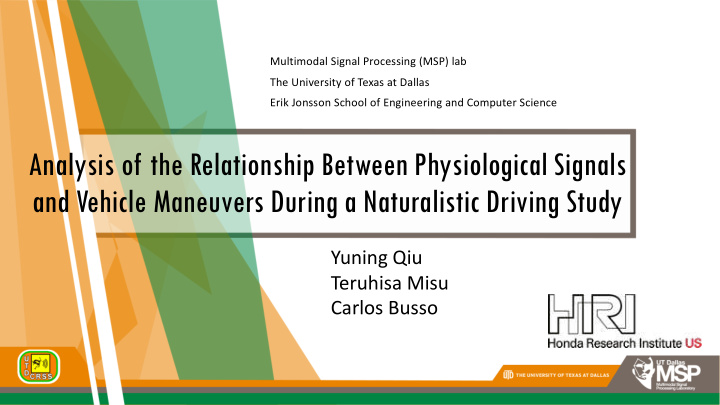



Multimodal Signal Processing (MSP) lab The University of Texas at Dallas Erik Jonsson School of Engineering and Computer Science Analysis of the Relationship Between Physiological Signals and Vehicle Maneuvers During a Naturalistic Driving Study Yuning Qiu Teruhisa Misu Carlos Busso
Introduction § Motivations: Therefore… § Physiological signals indicate human’s stress & mental states § Driving increases human’s stress level & cognitive workload 2
Experimental Analysis Heart Rate (HR) Breath Rate (BR) Skin Conductance (EDA) An example of the change of driver’s physiological signals during a Left Turn 3
Introduction § Main Contribution: Any Relationship? Drivers’ physiological signals Driving maneuvers § Physiological signals are complementary to CAN-Bus signal § Anticipatory signals § Analysis methods § Explore extreme changes on the driver’s physiological signals § Statistical analysis of physiological data during specific driving maneuvers § Discriminant analysis on physiological features to recognize specific driving maneuvers 4
1. Introduction 2. Related Work 3. Honda Research Institute Driving Dataset (HDD corpus) 4. Experimental Analysis 5. Conclusion
Related Work § Human’s physiological signals respond to the human’s autonomous nervous system § People experiencing anxiety can exhibit sustained periods with high Heart Rate and low variability [Kitney et al., 1981] § The ratio between low frequency (LF) components and high frequency (HF) components of the Heart Rate power spectrum is discriminative of stress level of an individual § An increase of LF/HF is associated with an increase in his/her stress level [Haruyuki et al., 1997] § Respiration Rate changes when the participants’ mental states change from relaxed to stressed [Begum et al., 2014] 6
Related Work § Driving a vehicle can increase the driver’s stress level, which increases the level of HR, BR and EDA signals [Nishigaki et al., 2018] & [Healey et al, 2005] § Previous studies analyze the relation between the driver’s physiological signals and driving maneuvers. § Features extracted from the HR and BR signals are used to cluster the physiological data into three classes: “normal”, “event”, and “noise” [Li et al., 2016] § Class “event” includes driver maneuvers § Features extracted from physiological data are used to predict lane change action [Murphey et al., 2015] § Physiological signals are useful for driving maneuver classification when combined with features extracted from the controller area network (CAN) bus data [Li et al., 2016] 7
1. Introduction 2. Related Work 3. Honda Research Institute Driving Dataset (HDD corpus) 4. Experimental Analysis 5. Conclusion
Honda Research Institute Driving Dataset Video of driving scenario Annotations of § Honda Research Institute Driving driving maneuver Dataset (HDD corpus) § 180 hours of naturalistic driving recordings (76 hours used in this task) § Collected by Honda Research Institute, USA, in San Francisco Bay Area § Road condition recorded by forward- facing in-vehicle camera § Annotations are manually added to the corpus with driving events § Drivers’ physiological data § Heart Rate (HR) § Breath Rate (BR) § Skin conductance (EDA) Collected physiological data 9
<latexit sha1_base64="CALtPqu1bEam9YZ6xLc6/38HtA0=">AEKnicbVNb9NAEHUdPkr4auHIZUQF4pIoRkhUyqUlSIAEIrRNW5RE0Xo9cVZ71q761SRye/hwl/h0gOo4soPYdf5bljJ0vi9nTdvxuMw5UybWu1qy/duHnr9vad8t179x83Nl9dKplpi2qORSnYdEI2cCW4YZjuepQpKEHM/CYcPxZyNUmklxYsYpdhMSC9ZnlBgL9Xb9g06IMRO5IWHGiZrkaR5U92kygW+Q5i6YlDsDJ1+G53AohDRFqgbodObMO0l4JVJshAIOqaPt3Q/C2MI4fU2J1kzEdfiIfQMmU6IORywezOMC5kRQBDogIsY5vY41lNT6gvDhUrBVWVdACJXNGawILKFPqGJc+j42LMl4pje8HxuZ1uEtjhgxuNJog2QaHc9iW7IhrSntUupwokjfjhW4K1qHJkaWUYxYqknUECOgRK0oHRqDYlat6Mo2AyMcMrnfTokXdE5siIz+UZmKsxCUx+fRUVJEkHI6Ji6pVnUXAi6xtcqfEXO5cVc78ilX0g1XHUOAq1ljGUxw6X1DoposS/l3s5erVorDmwGwSzY82an2du57ESZoltn3L7FdtBLTXdnCjnNltsyNOCR2SGNs2FCRB3c2LVZ/AM4tE0JfKPsJAga5m5CTRepyE9mZCzEBf5xz4P6dmf5+N2cizex3odNC/YyDkeD+G4iYsqvMxzYgVDHr1S2lItQtuRtCcL3lzeD0ZTWoVYMvr/YO3szGse098Z56L7zAe+0deO+9ptfyqP/d/+n/8n+XfpQuS1elP9Or/tYs57G3dkp/wFeTVr8</latexit> <latexit sha1_base64="CALtPqu1bEam9YZ6xLc6/38HtA0=">AEKnicbVNb9NAEHUdPkr4auHIZUQF4pIoRkhUyqUlSIAEIrRNW5RE0Xo9cVZ71q761SRye/hwl/h0gOo4soPYdf5bljJ0vi9nTdvxuMw5UybWu1qy/duHnr9vad8t179x83Nl9dKplpi2qORSnYdEI2cCW4YZjuepQpKEHM/CYcPxZyNUmklxYsYpdhMSC9ZnlBgL9Xb9g06IMRO5IWHGiZrkaR5U92kygW+Q5i6YlDsDJ1+G53AohDRFqgbodObMO0l4JVJshAIOqaPt3Q/C2MI4fU2J1kzEdfiIfQMmU6IORywezOMC5kRQBDogIsY5vY41lNT6gvDhUrBVWVdACJXNGawILKFPqGJc+j42LMl4pje8HxuZ1uEtjhgxuNJog2QaHc9iW7IhrSntUupwokjfjhW4K1qHJkaWUYxYqknUECOgRK0oHRqDYlat6Mo2AyMcMrnfTokXdE5siIz+UZmKsxCUx+fRUVJEkHI6Ji6pVnUXAi6xtcqfEXO5cVc78ilX0g1XHUOAq1ljGUxw6X1DoposS/l3s5erVorDmwGwSzY82an2du57ESZoltn3L7FdtBLTXdnCjnNltsyNOCR2SGNs2FCRB3c2LVZ/AM4tE0JfKPsJAga5m5CTRepyE9mZCzEBf5xz4P6dmf5+N2cizex3odNC/YyDkeD+G4iYsqvMxzYgVDHr1S2lItQtuRtCcL3lzeD0ZTWoVYMvr/YO3szGse098Z56L7zAe+0deO+9ptfyqP/d/+n/8n+XfpQuS1elP9Or/tYs57G3dkp/wFeTVr8</latexit> <latexit sha1_base64="CALtPqu1bEam9YZ6xLc6/38HtA0=">AEKnicbVNb9NAEHUdPkr4auHIZUQF4pIoRkhUyqUlSIAEIrRNW5RE0Xo9cVZ71q761SRye/hwl/h0gOo4soPYdf5bljJ0vi9nTdvxuMw5UybWu1qy/duHnr9vad8t179x83Nl9dKplpi2qORSnYdEI2cCW4YZjuepQpKEHM/CYcPxZyNUmklxYsYpdhMSC9ZnlBgL9Xb9g06IMRO5IWHGiZrkaR5U92kygW+Q5i6YlDsDJ1+G53AohDRFqgbodObMO0l4JVJshAIOqaPt3Q/C2MI4fU2J1kzEdfiIfQMmU6IORywezOMC5kRQBDogIsY5vY41lNT6gvDhUrBVWVdACJXNGawILKFPqGJc+j42LMl4pje8HxuZ1uEtjhgxuNJog2QaHc9iW7IhrSntUupwokjfjhW4K1qHJkaWUYxYqknUECOgRK0oHRqDYlat6Mo2AyMcMrnfTokXdE5siIz+UZmKsxCUx+fRUVJEkHI6Ji6pVnUXAi6xtcqfEXO5cVc78ilX0g1XHUOAq1ljGUxw6X1DoposS/l3s5erVorDmwGwSzY82an2du57ESZoltn3L7FdtBLTXdnCjnNltsyNOCR2SGNs2FCRB3c2LVZ/AM4tE0JfKPsJAga5m5CTRepyE9mZCzEBf5xz4P6dmf5+N2cizex3odNC/YyDkeD+G4iYsqvMxzYgVDHr1S2lItQtuRtCcL3lzeD0ZTWoVYMvr/YO3szGse098Z56L7zAe+0deO+9ptfyqP/d/+n/8n+XfpQuS1elP9Or/tYs57G3dkp/wFeTVr8</latexit> <latexit sha1_base64="CALtPqu1bEam9YZ6xLc6/38HtA0=">AEKnicbVNb9NAEHUdPkr4auHIZUQF4pIoRkhUyqUlSIAEIrRNW5RE0Xo9cVZ71q761SRye/hwl/h0gOo4soPYdf5bljJ0vi9nTdvxuMw5UybWu1qy/duHnr9vad8t179x83Nl9dKplpi2qORSnYdEI2cCW4YZjuepQpKEHM/CYcPxZyNUmklxYsYpdhMSC9ZnlBgL9Xb9g06IMRO5IWHGiZrkaR5U92kygW+Q5i6YlDsDJ1+G53AohDRFqgbodObMO0l4JVJshAIOqaPt3Q/C2MI4fU2J1kzEdfiIfQMmU6IORywezOMC5kRQBDogIsY5vY41lNT6gvDhUrBVWVdACJXNGawILKFPqGJc+j42LMl4pje8HxuZ1uEtjhgxuNJog2QaHc9iW7IhrSntUupwokjfjhW4K1qHJkaWUYxYqknUECOgRK0oHRqDYlat6Mo2AyMcMrnfTokXdE5siIz+UZmKsxCUx+fRUVJEkHI6Ji6pVnUXAi6xtcqfEXO5cVc78ilX0g1XHUOAq1ljGUxw6X1DoposS/l3s5erVorDmwGwSzY82an2du57ESZoltn3L7FdtBLTXdnCjnNltsyNOCR2SGNs2FCRB3c2LVZ/AM4tE0JfKPsJAga5m5CTRepyE9mZCzEBf5xz4P6dmf5+N2cizex3odNC/YyDkeD+G4iYsqvMxzYgVDHr1S2lItQtuRtCcL3lzeD0ZTWoVYMvr/YO3szGse098Z56L7zAe+0deO+9ptfyqP/d/+n/8n+XfpQuS1elP9Or/tYs57G3dkp/wFeTVr8</latexit> Honda Research Institute Driving Dataset § Annotations § A four-layer representation § Relative to characterize driver distractions Annotations Goal-driven Intersection passing; Left turn; Right turn; Left lance Action change; Right lance change; Crosswalk passing; U- turn; Left lane branch; Right lane branch; Merge Stimulus- Stop; Deviate driven Action Cause Sign; Congestion; Tra ffi c light; Pedestrian; Parked car Attention Crossing vehicle; Crossing pedestrian; Red light; Cut-in; Sign; On-road bicyclist; Parked vehicle; Merging vehicle; Yellow light; Road work; Pedestrian near ego lane 10
1. Introduction 2. Related Work 3. Honda Research Institute Driving Dataset (HDD corpus) 4. Experimental Analysis 5. Conclusion
Experimental Analysis An example of Physiological signal § Extreme Value of Physiological Signals § Physiological Signals: Heart Rate (HR) Breath Rate (BR) Skin Conductance (EDA) § Window size: 10 min § Thresholds (green dash lines): Mean ± Standard deviation The beginning § 5% (blue) and 95% (yellow) quantiles of an extreme outside the range between thresholds as Extreme Values 8 sec 4 sec 12
Recommend
More recommend